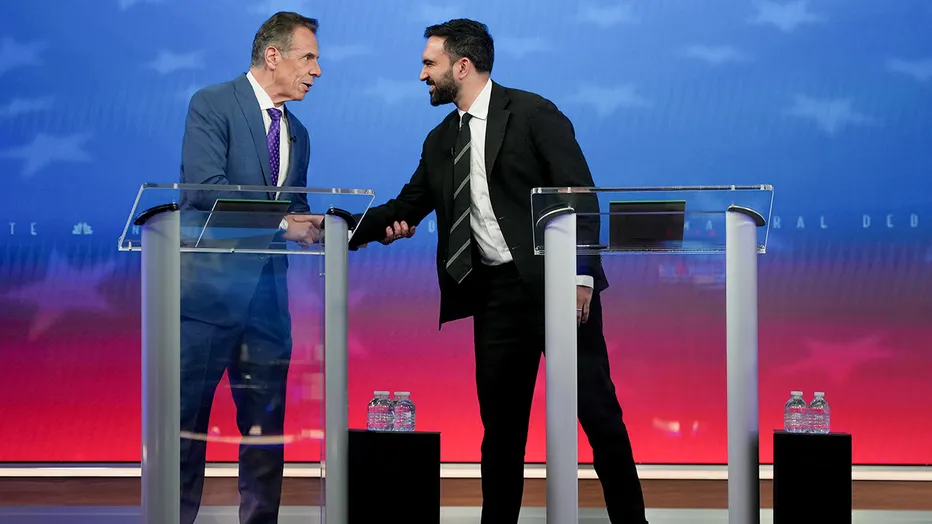FOX 5: Candidates prepare for final debate l Oct. 22 election update
FOX 5: Candidates prepare for final debate l Oct. 22 election update
By Michael Stallone , Adeja Shivonne and Alex Meier

The Brief
- Zohran Mamdani, Andrew Cuomo and Curtis Sliwa will meet for the final time on the debate stage.
- Last week’s fiery first round saw sharp exchanges, including over President Trump’s deepening role in city politics.
- Election Day in New York City is just 13 days away.
The fiery first round last week saw sharp exchanges over affordability, crime, and President Donald Trump’s deepening role in city politics.
What time is the debate tonight?
The debate, hosted by Spectrum NY1, The City and WNYC/Gothamist, begins at 7 p.m.
Watch live debate analysis
We’ll begin streaming live debate reaction and analysis on our YouTube page embedded below. Click here if you’re having trouble viewing.
NYC mayoral debate tonight: Who won the last one?
Dig deeper:
While no clear winner emerged, analysts say Mamdani held his lead by avoiding major missteps, Cuomo relied on his executive experience and Sliwa’s offbeat humor and streetwise anecdotes, including stories about his mafia run-ins, made him an unlikely social media favorite.
Ben Max, host of the Max Politics podcast, joined Good Day New York on Friday morning with his analysis of the debate.
When asked if anyone won, Max said there were no “game changers” from the debate, meaning “Zohran Mamdani, as the front-runner, had a pretty good debate because he didn’t make any huge gaff and nobody brought him down significantly.”
Max added: “But I did think, in the debate itself, if you just look at how it was debated, Curtis Sliwa had a pretty good night.”
When is Election Day in NYC?
What’s next:
Election Day 2025 is Tuesday, Nov. 4, 13 days away.
Timeline, key dates
- Wednesday, Oct. 22: The second mayoral debate.
- Saturday, Oct. 25: Application for voter registration must be received no later than Oct. 25.
- Saturday, Oct. 25 through Sunday, Nov. 2: The early voting period. Early voting hours vary.
- Tuesday, Nov. 4: Election Day. Polls are open from 6 a.m. to 9 p.m.
You can check your registration status online here.
To find your local poll site, click here.
Who’s ahead? Polls in the NYC mayor’s race
By the numbers:
Here’s a look at some of the latest polls in the race for NYC mayor:
- A newly released report by Gotham Polling and the city AARP found 44.6% of New Yorkers would vote for Mamdani if Sliwa quit the race, compared to 40.7% saying they’d back Cuomo – with a margin of error of 4 points that puts Cuomo within striking distance.
- The latest Fox News poll shows Mamdani with a 24-point lead among registered voters in New York City. He’s at 52% support among likely voters, while Cuomo polls at 28% and Sliwa polls at 13%.
- Quinnipiac University has Mamdani with a 13-point lead in its latest poll, with Mamdani at 46% of the vote, while Cuomo and Sliwa poll at 33% and 15%, respectively.
Betting odds
Some companies have begun taking what amounts to bets on the outcome of the NYC mayoral election.
- Polymarket: The latest odds from Polymarket show Mamdani at a 93% chance of winning.
- Kalshi: The latest odds from Kalshi show Mamdani at a 91% chance of winning.
- Oddschecker: Mamdani is at -2000 to win.
NYC election news today
- Ex-NY Rep. George Santos reveals why he’s fleeing NYC if Zohran Mamdani is elected mayor (New York Post)
- Mamdani holds strong lead in NYC mayor’s race predictive markets (NewsNation)
- Mamdani unveils plan to root out ‘duplicative’ education spending at city’s public schools (amNewYork)
Where are the candidates today?
Zohran Mamdani
- Mamdani has no public schedule.
Curtis Sliwa
- 8:30 a.m. – Sid & Friends in the Morning, WABC, live, phone.
Andrew Cuomo
- Cuomo has no public schedule.
- 7 p.m. – Second mayoral debate, LaGuardia Community College in Queens.
- 9:20 p.m. – Hannity, live from the debate location.
How to track election results
What you can do:
Bookmark FOX 5 NY’s election results page to track results in real time when polls close on Tuesday, Nov. 4.
Meet the candidates
Curtis Sliwa – Republican
The backstory:
Returning to the mayoral race after his 2021 defeat to New York City Mayor Eric Adams, Curtis Sliwa brings his tough-on-crime message back to the Republican forefront. The Guardian Angels founder and outspoken radio host is banking on his core base in conservative outer-borough neighborhoods.
He has focused his campaign on public order and community-focused housing.
Andrew Cuomo – Independent
After conceding defeat in the Democratic primary, former New York Gov. Andrew Cuomo has officially qualified to run as an independent in the general election, staging a late comeback that could reshape the race. Cuomo is presenting himself as a steady hand with deep experience, seeking to appeal to moderates, independents and disaffected Democrats wary of both Mamdani’s progressivism and Sliwa’s conservatism.
He has focused his campaign on restoring public safety and affordability. He calls for adding 5,000 officers to the NYPD and increasing patrols in subways and retail corridors.
Zohran Mamdani – Democrat
At 33, Zohran Mamdani stands out as a Democratic Socialist and a rising star in New York City politics. As a state assemblyman, Mamdani surged ahead on a fiercely progressive platform promising rent freezes, fare-free public transit, universal childcare, and an unprecedented push for public housing expansion.
His campaign is centered on housing, affordability and equity.
Your ballot, explained
Why do some candidates appear more than once on the ballot?
You might notice mayoral candidates like Zohran Mamdani or Curtis Sliwa listed twice — that’s because they’re endorsed by multiple parties. Mamdani appears on both the Democratic and Working Families party lines, while Sliwa is listed under Republican and Protect Animals.
But remember: You can only vote once for a candidate. Filling in both circles for the same person won’t give them two votes — it just risks confusing your ballot. So, pick one circle next to your preferred candidate’s name, under either party line.
Is this a ranked-choice election?
Not this time. Unlike the primaries, which used ranked-choice voting, the general election is winner-takes-all. That means you vote for one candidate per race, and whoever gets the most votes wins.
Why are some candidates who dropped out still on the ballot?
You might still see names like Jim Walden and Mayor Eric Adams on the ballot, even though they’ve exited the race. That’s because they dropped out after the ballot printing deadline — too late for the Board of Elections to remove them.
If you want your vote to count toward an active candidate, make sure to choose someone still in the race.
What other races are on the ballot besides the mayor’s race?
A lot! While the mayor’s race draws most of the attention, there are several down-ballot races that directly affect neighborhoods and day-to-day city life — including:
- Public Advocate
- City Council seats
- District Attorney
What are the ballot proposals this year?
Dig deeper:
Flip over your ballot, and you’ll see six ballot proposals. The deal with land use, affordable housing, creating a digital map for the city and an election year shift.

